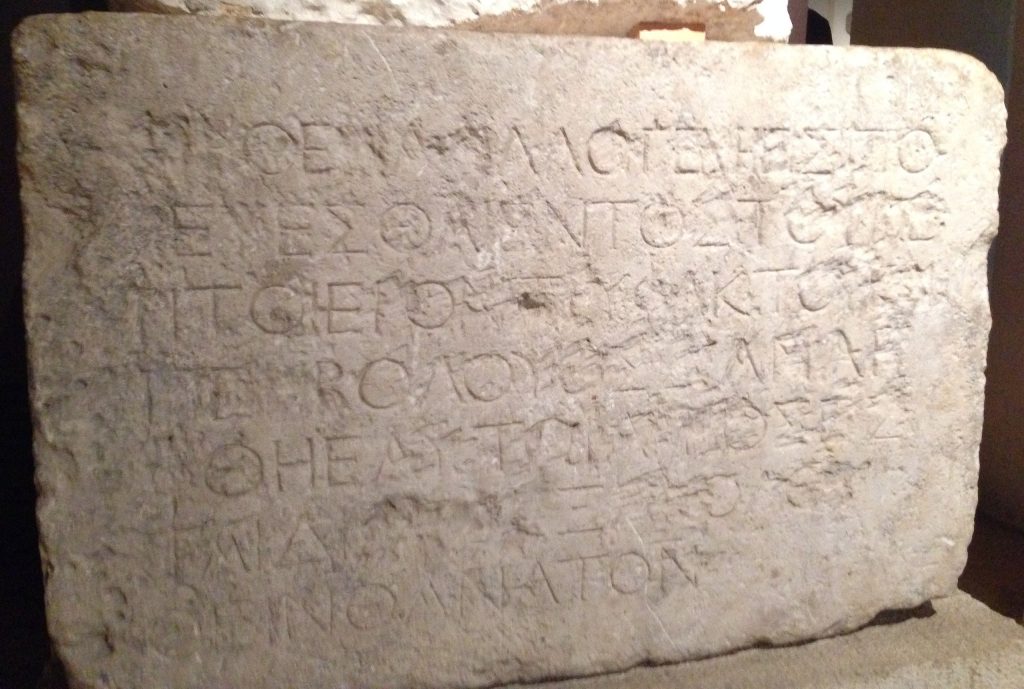Dividing Wall of Hostility & Law in Dogmas (Eph. 2.15)
Author: Bobby Valentine | Filed under: Ephesians, Exegesis, Paul, UnityYesterday I noted my understanding of Colossians 2.14, which does not teach that the “law” was nailed to the cross. A couple of brothers cited Ephesians 2.15 as a response. So here is my brief reply to that. In the NIV, Ephesians 2.14-15 reads,
“For he himself is our peace, who has made the two groups one and has destroyed the barrier, the dividing wall of hostility, by setting aside in his flesh the law with its commands and regulations.”
By way of response, I would argue that Colossians 2.14’s meaning is not determined by Ephesians 2.14-16.
With that said, I will deny that EITHER text refers to the removal of the “law.” First, I simply stand by and reiterate what was already said on Colossians 2.14. There is no reference to the “nomos” in Colossians at all. The term never occurs even once.
Ephesians 2.14-15 requires first century eyes as well. The phrase in Ephesians 2 is unique: νόμον τῶν ἐντολῶν ἐν δόγμασιν.
Since Paul just referred to the “dividing wall of hostility” this gives us a clue to what Paul is referring. The “temple” is a major framing category in Ephesians and runs throughout the letter. And explicitly so in our context here. Paul uses temple language throughout and we should both recognize it and understand it.
Modern readers may or may not know (frequently the latter) that the Jerusalem temple (Herod’s temple) had a literal wall, a barrier, that separated the Court of the Gentiles from the Court of Women.
This wall/barrier was about 3.5 ft high. Gentiles could move freely here. Gentiles could “observe” what was happening. Gentiles could hear the singing and join in prayer. Gentiles could even offer sacrifice THROUGH a representative from here. Gentiles could worship FROM A DISTANCE in the Court of Gentiles.
But they could go no further. This is the dividing wall of 2.14. This wall/barrier was a physical, historical, reality in the Jerusalem temple that Paul would see every time he was in the Temple.
On that wall/barrier, spaced throughout, were “dogmas.” These “dogmas” issued a command and warned Gentiles from proceeding further on penalty of death. Paul never refers to the torah of Moses as δόγμασιν. Here, he says there is a commandment in the dogmas. If this is a reference to Exodus or Deuteronomy it is a unique reference. Paul likely knew the Hebrew Scriptures better than me but I am not aware of any commandment in the Torah that bans Gentiles from the temple. In fact, the Torah frequently commands Israelites to include aliens in their sacrificial feasts. Likewise there was no “Court of Gentiles” in the Tabernacle nor in Solomon’s Temple.
But numerous scholars today think Paul is referring to these decrees in Herod’s Temple itself. King Jesus has removed these barriers and given Gentiles “access” or “brought near” (v.13, προσάγω, a temple word/liturgical word ironically from Leviticus!) to God “with the saints.“
As noted above, there were no “walls/barriers” in Solomon’s Temple. These barriers came into being following the Maccabean period when Gentiles made Jewish identity markers a crime. Jews pushed back.
The Jewish historian, Josephus tells us of these dogmas and quotes them in his Jewish Wars. Two of these “decrees/dogmas” have been recovered by archeologists. One in the 1871 and one in the 1936.
My understanding of Ephesians 2.15 is this. Paul has in mind extra biblical tradition that has obtained the force of “law” in the temple. This oral decree that became a physical barrier in the temple has been removed by King Jesus. Here is a pic of one of decrees.
A good discussion of the Temple warnings can be found in: Llewelyn, Stephen R., and Dionysia Van Beek. “Reading the Temple Warning as a Greek Visitor” Journal for the Study of Judaism in the Persian, Hellenistic, and Roman Period, vol. 42, no. 1, 2011, pp. 1–22.

July 14th, 2023 at 10:10 am
Thank you for making this clarification. Good scholarship is always helpful toward helping believers to be better informed.